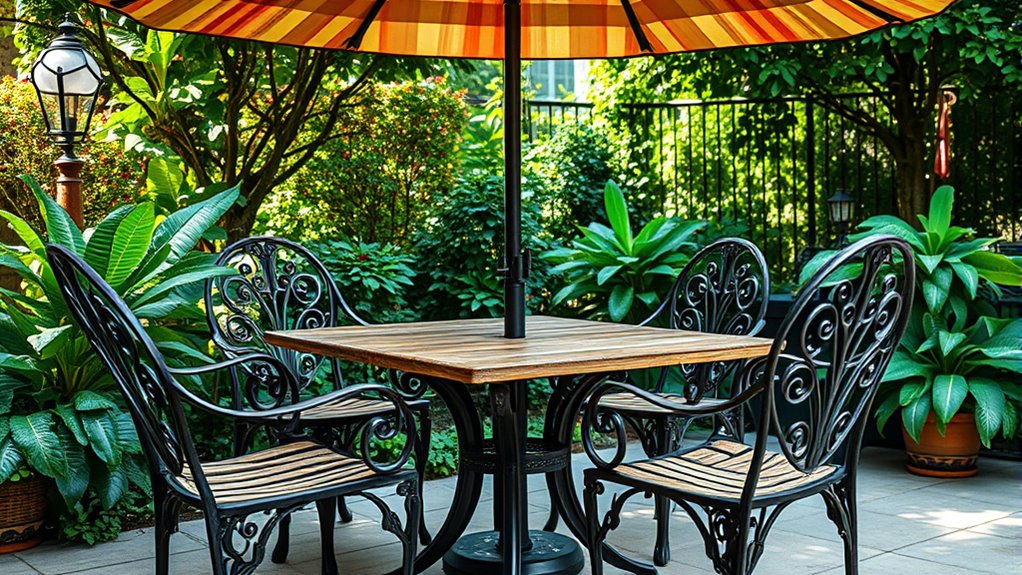To guarantee your outdoor seating stays stable and weather-resistant, start by evaluating your ground’s support and leveling uneven areas. Choose durable, weather-resistant materials like powder-coated metal or synthetic fabrics, and securely anchor furniture with weights or stakes. Incorporate wind barriers and use sturdy bases designed for outdoor use. Regular maintenance, protective covers, and seasonal storage help prolong your furniture’s life. Keep these tips in mind for a safer, longer-lasting outdoor setup. Discover more tips for ideal stability and weather readiness.
Key Takeaways
- Ensure ground leveling and proper foundation materials like concrete or gravel to prevent uneven settling and enhance stability.
- Use heavy-duty anchors, weights, or ground stakes to secure furniture against shifting from wind or weather.
- Select weather-resistant materials such as powder-coated metal, treated wood, or synthetic fabrics for durability.
- Incorporate wind barriers, screens, or fencing and strategically place furniture to reduce wind impact and improve stability.
- Regularly maintain and store furniture properly, including covers and seasonal storage, to preserve stability and weather resistance.
Assessing Ground Stability for Outdoor Furniture
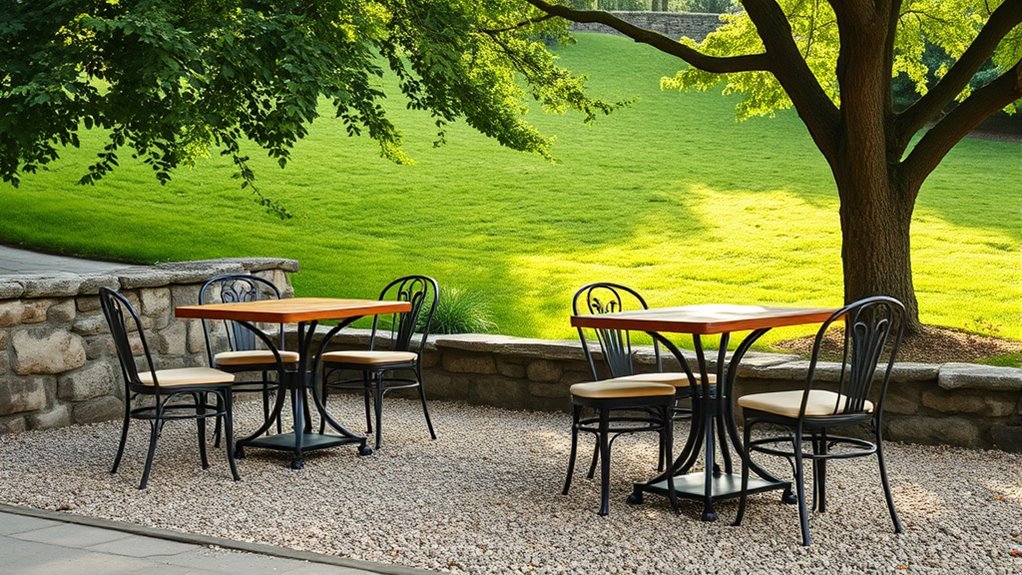
Before placing outdoor furniture, you need to make sure the ground is stable enough to support it. Start with ground leveling to create an even surface, preventing wobbling or tipping. Use a level tool to check for uneven spots and fill in low areas with soil or gravel. Soil testing is essential to determine if the ground can handle the weight of your furniture. Test the soil’s drainage and compaction by pouring water and observing how quickly it absorbs. If the soil is loose or drains poorly, consider adding a layer of compacted gravel or installing a sturdy base. Proper ground stability guarantees your outdoor furniture remains safe and steady, preventing damage and accidents over time. Additionally, understanding the ground’s composition can help you choose the best foundation for your outdoor setup.
Selecting Weather-Resistant Materials

Choosing weather-resistant materials is essential for outdoor seating that lasts. You’ll want options that stand up to the elements and require minimal maintenance. Consider the durability, longevity, and care tips to keep your furniture looking great year after year. Additionally, select materials like hardwoods or composite woods that are known for their environmental benefits, supporting sustainable use and reducing environmental impact.
Material Durability and Longevity
Selecting weather-resistant materials is essential when it comes to outdoor seating, as these choices determine how well your furniture withstands the elements over time. When choosing fabric options, look for those made from synthetic fibers like acrylic, polyester, or solution-dyed fabrics, which resist fading, moisture, and mold. These fabrics offer excellent color longevity, ensuring your furniture maintains its vibrant appearance season after season. Metal frames, especially those with powder coating or stainless steel, provide durability against rust and corrosion. Likewise, treated wood or composite materials resist warping and rot. By selecting high-quality, weather-resistant materials, you enhance the longevity of your outdoor furniture, saving you money and effort on replacements or repairs in the long run. Inspirational quotes about fatherhood
Maintenance and Care Tips
To keep your weather-resistant outdoor furniture performing at its best, regular maintenance and proper care are essential. Establish simple cleaning routines, such as wiping surfaces with a damp cloth and mild soap, to prevent dirt buildup. For upholstery care, vacuum or brush fabric regularly to remove debris and prevent mold. Protect your furniture from harsh weather when not in use, using covers or storing indoors during storms. The table below helps visualize maintenance tasks:
| Task | Frequency |
|---|---|
| Wipe surfaces | Weekly |
| Clean upholstery | Monthly |
| Inspect for damage | Quarterly |
| Apply protective sealant | Annually |
| Cover or store | During storms |
Consistent upkeep guarantees your outdoor seating stays durable, vibrant, and inviting for years. Regularly assessing your weather-resistant materials helps identify potential issues early and prolongs the lifespan of your furniture.
Anchoring and Securing Outdoor Seating

To keep your outdoor seating safe and stable, you need to choose the right anchoring methods. Different anchor types, like weights or stakes, work best depending on your surface and setup. Proper securing techniques guarantee your furniture stays put, even in strong winds or busy environments. Using appropriate anchoring solutions can significantly enhance stability and prevent accidents.
Anchor Types and Methods
Securing outdoor seating is essential to guarantee safety and stability, especially in areas prone to wind or high foot traffic. You have various anchor types to choose from, including concrete weights, ground stakes, and decorative anchor options that blend aesthetics with function. When selecting anchors, consider the environment and furniture weight. Proper anchor installation techniques ensure your seating stays put, preventing accidents. For example, using heavy-duty ground sleeves or weighted bases can provide extra stability. Decorative anchors like ornate weights or custom-designed stakes add visual appeal while securing your setup. Here’s a quick comparison:
| Anchor Type | Best Use |
|---|---|
| Concrete weights | Heavy, high wind areas |
| Ground stakes | Soft ground, temporary setups |
| Decorative anchor options | Aesthetics combined with stability |
| Anchor installation techniques | Ensures secure attachment |
Additionally, choosing the right anchor installation techniques can significantly enhance the stability of your outdoor seating.
Securing Techniques for Stability
Choosing the right anchoring techniques guarantees your outdoor seating remains stable and safe, especially in challenging conditions like strong winds or uneven surfaces. Secure anchors, such as ground stakes or heavy-duty weights, provide a solid foundation, preventing tipping or shifting. You can also incorporate decorative accents, like stylish planters or decorative stones, that double as stabilizers, enhancing seating comfort while adding visual appeal. When securing tables and chairs, ensure they’re firmly anchored to avoid wobbling. Proper securing not only improves stability but also creates a more inviting environment for guests. Remember, stability is key to seating comfort, so select anchoring methods that blend functionality with your outdoor decor. This approach keeps your seating safe and visually appealing, regardless of weather or terrain. Additionally, understanding outdoor furniture materials can help you choose the most durable and weather-resistant options for long-lasting stability.
Choosing the Right Base and Footing Designs
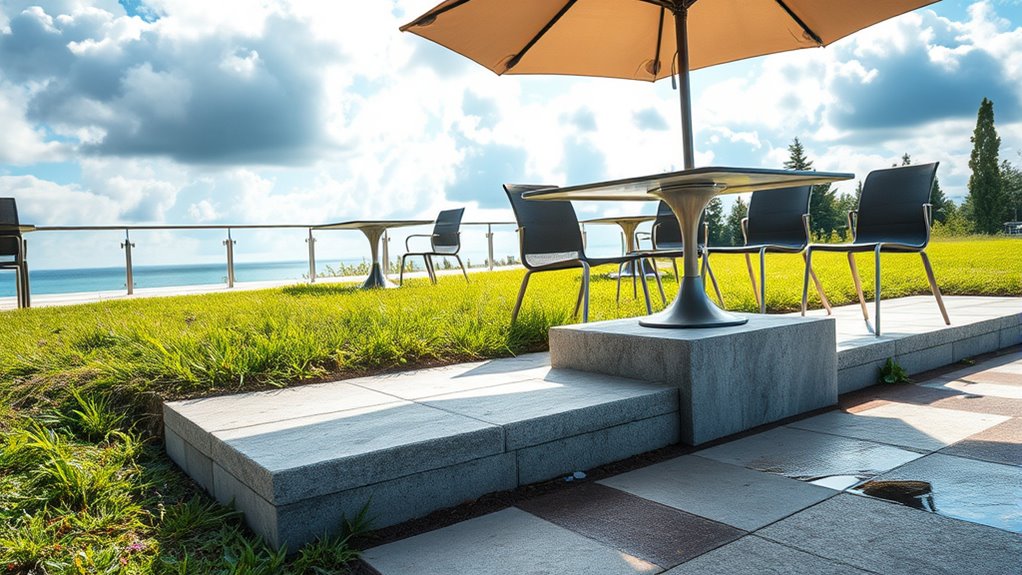
Selecting the right base and footing designs is essential for ensuring your outdoor seating remains stable and durable over time. Proper ground leveling creates a solid foundation, preventing uneven settling that can compromise stability. When choosing footings, consider materials like concrete, gravel, or pavers, which provide different levels of support and drainage. Your goal is to blend function with aesthetic design, so select bases that complement your overall outdoor look while offering strength. A well-designed footing not only supports the weight of the seating but also resists shifting caused by weather conditions. By focusing on proper ground leveling and choosing suitable materials, you ensure your outdoor seating stays safe, stable, and visually appealing for years to come. Incorporating proper foundation techniques can also help prevent potential issues caused by shifting or settling over time.
Maintenance Practices to Enhance Durability
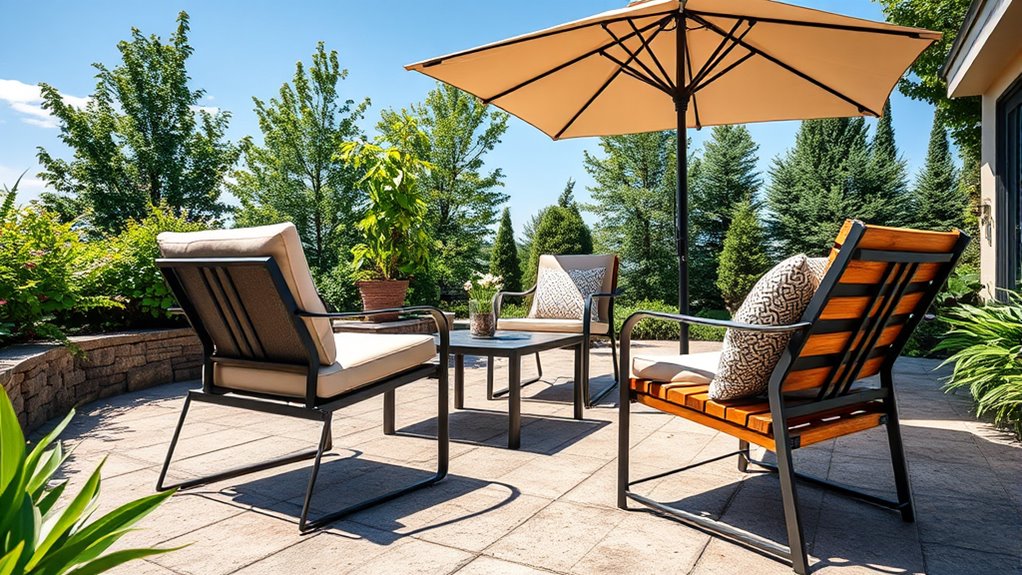
Maintaining your outdoor seating regularly is key to extending its lifespan and keeping it looking great. Establishing consistent cleaning routines removes dirt and prevents buildup that can cause damage. For example, wipe down surfaces weekly with mild soap and water. Additionally, inspecting your furniture for chipped or peeling paint allows you to perform touch-ups promptly, preventing rust or rot. Use the following table for quick reference:
| Cleaning Routine | Paint Touch-Ups | Tips |
|---|---|---|
| Weekly wash | Repair chips | Use weather-resistant paint |
| Remove debris | Sand area lightly | Follow manufacturer instructions |
| Check for mold | Repaint as needed | Maintain furniture’s appearance |
Regularly applying paint touch-ups can also prevent further deterioration and maintain the aesthetic appeal of your outdoor furniture. Adhering to these practices keeps your outdoor seating durable and visually appealing.
Tips for Protecting Furniture From the Elements

To protect your outdoor furniture from the elements, start by investing in quality covers that fit snugly and are made from weather-resistant materials. This shields your furniture from rain, sun, and dirt, extending its lifespan. When it comes to decorative cushions, store them indoors or in waterproof storage when not in use to prevent mold and fading. Proper umbrella placement is also key; position umbrellas to provide shade that shields furniture surfaces and cushions from direct sunlight, reducing wear and color fading. Confirm umbrellas are securely anchored to withstand wind gusts. Regularly check and adjust covers and umbrellas to maintain their effectiveness. Additionally, incorporating sound vibrations can promote relaxation and help you unwind after outdoor maintenance, ensuring your space remains a peaceful retreat. Taking these steps helps keep your outdoor setup looking fresh and in top condition, no matter the weather.
Incorporating Wind-Resistant Features
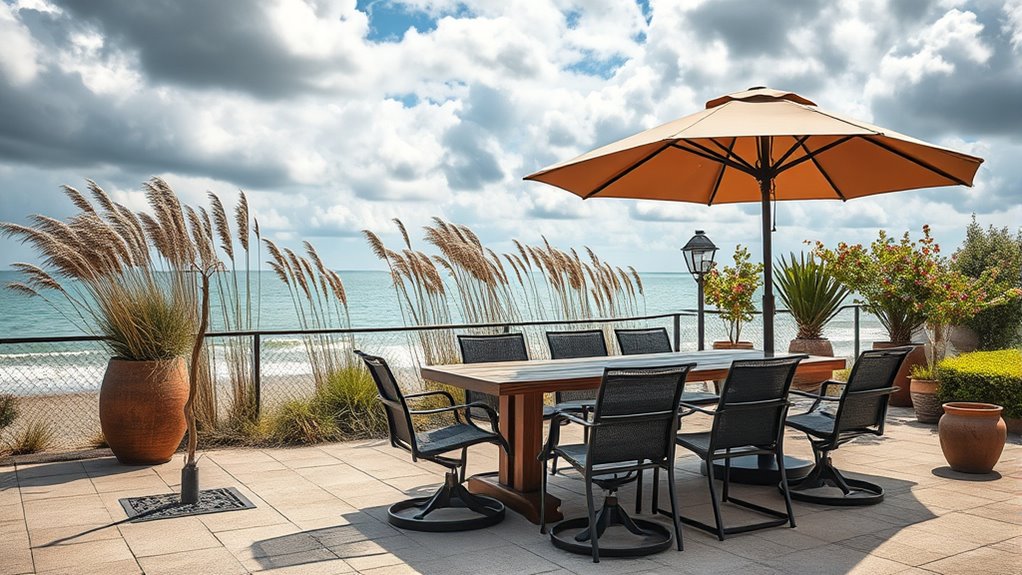
Since wind can easily topple lightweight outdoor furniture or cause damage, incorporating wind-resistant features is essential for a secure and durable setup. Installing wind barriers, such as screens or fencing, helps block gusts and reduces the risk of furniture being blown over. Anchoring furniture with weights or stakes enhances gust resistance, keeping items stable during strong winds. Consider using heavier materials for tables and chairs, which naturally oppose movement. Strategically placing wind barriers can also create sheltered zones, minimizing wind impact. By combining barriers and proper anchoring, you ensure your outdoor seating remains safe and intact, even in breezy conditions. These measures provide peace of mind and extend the lifespan of your furniture in unpredictable weather.
Considering Mobility and Flexibility in Design
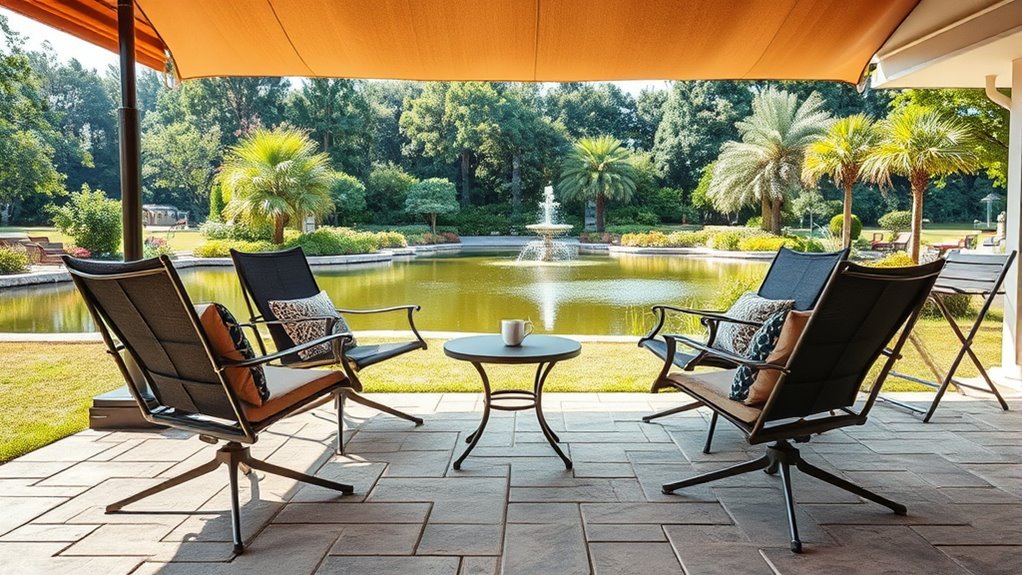
Designing outdoor seating with mobility and flexibility in mind allows you to easily adapt your space for different occasions or group sizes. Using portable solutions and flexible configurations, you can quickly rearrange or expand your seating area without hassle. This approach ensures your outdoor space remains functional and inviting, regardless of the event. For example, lightweight tables and stackable chairs enable effortless movement and storage. Consider the following options to maximize flexibility:
| Portable Solutions | Flexible Configurations |
|---|---|
| Folding chairs | Modular seating arrangements |
| Lightweight tables | Movable furniture pieces |
| Stackable options | Adjustable layouts |
| Collapsible furniture | Multi-purpose setups |
| Portable umbrellas | Configurable groupings |
Planning for Seasonal Changes and Storage
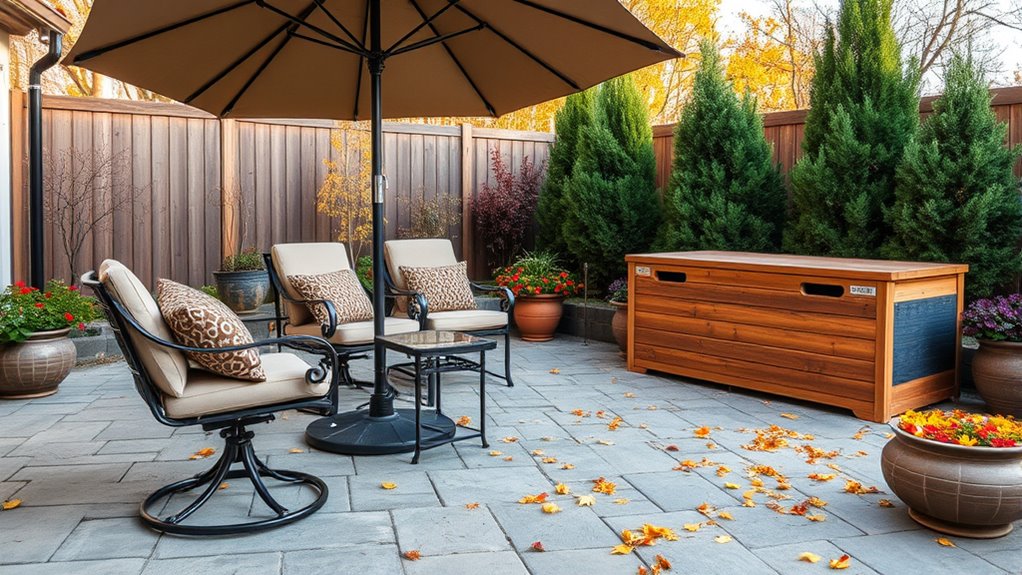
Preparing your outdoor seating for seasonal changes guarantees it stays functional and in good condition year-round. To safeguard your furniture, plan for seasonal storage during harsh weather months. Use weatherproof covers to shield items from rain, snow, and UV rays, extending their lifespan. Consider investing in stackable or foldable furniture that’s easy to store when not in use. Storing cushions indoors or in waterproof containers prevents mold and fading. Regularly clean your furniture before covering or storing it to prevent dirt buildup. Keep a checklist to ensure all pieces are accounted for and properly protected. Proper planning minimizes damage, saves money, and keeps your outdoor space inviting all year. With these tips, your seating will be ready for any season.
Frequently Asked Questions
How Do I Prevent Outdoor Furniture From Sinking Into Soft Ground?
To prevent outdoor furniture from sinking into soft ground, you should use ground stabilization techniques like laying gravel or installing pavers to create a solid foundation. Consider adding foundation solutions such as concrete pads or adjustable feet to distribute weight evenly. These steps help stabilize the ground and prevent sinking, ensuring your outdoor seating remains sturdy and safe regardless of weather conditions or soil softness.
What Are the Best Ways to Handle Snow and Ice on Outdoor Seating?
Oh, the joys of winter wonderlands on outdoor furniture—what could go wrong? To handle snow and ice, start with regular snow removal to prevent buildup and slipping hazards. Use ice prevention methods like sand or salt to keep surfaces grippy. Cover your furniture with weatherproof covers or bring pieces indoors during storms. A little effort now keeps your outdoor setup safe, stylish, and ready for spring’s first toast.
Can Lightweight Furniture Withstand Strong Winds Without Tipping?
Lightweight furniture often struggles with wind resistance and furniture stability during strong winds. To prevent tipping, you should secure your pieces with weights or anchors, and choose designs that distribute weight evenly. Avoid placing lightweight furniture in open, exposed areas. By taking these precautions, you can enhance wind resistance and ensure your outdoor seating remains stable, even when gusts pick up unexpectedly.
How Do I Choose Furniture That Adapts to Changing Weather Conditions?
Sure, you want furniture that laughs in the face of weather chaos. Look for pieces with weatherproof fabrics that resist rain and stains, and UV resistant finishes that prevent sun damage. Choose lightweight yet sturdy designs for easy relocation, but guarantee they’re built tough enough to handle sudden storms. This way, your outdoor setup stays fabulous, no matter if it’s sunshine, rain, or wind—because who wants boring, weather-sensitive furniture?
What Safety Precautions Should I Take When Anchoring Heavy Outdoor Furniture?
When anchoring heavy outdoor furniture, you should focus on using reliable anchoring methods like ground stakes, weights, or brackets. Guarantee all anchors are securely fastened and check for stability regularly. Follow safety tips such as avoiding loose fittings, placing furniture on level surfaces, and inspecting anchors after storms. Properly anchored furniture reduces the risk of tipping or flying, keeping your outdoor space safe for everyone.
Conclusion
Remember, a sturdy outdoor setup starts with careful planning. By evaluating ground stability, choosing weather-resistant materials, and securing your furniture properly, you’ll enjoy your outdoor space year-round. Incorporate wind-resistant features and plan for seasonal changes to keep your furniture durable and functional. As the saying goes, “A stitch in time saves nine.” When you take proactive steps now, you’ll ensure your outdoor seating remains a comfortable haven for seasons to come.
